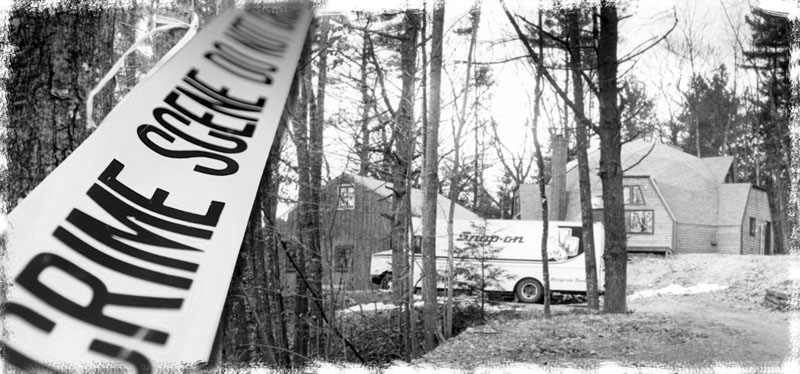Brian S. Kowalczyk was shot at eight times — hit once — and then stabbed multiple times on the second floor of the geodesic dome home he shared with his wife on the shore of Maranacook Lake.
Winthrop police found Kowalczyk’s body just before midnight after his wife, Leeanne Kowalczyk, called them from New York in a panic. He should have been home, she said, after a long workday selling from his Snap-On Tools truck.
She couldn’t reach him by phone to tell him about the prospective homes she had been touring in Glen Falls, N.Y., where the Kowalczyks were to relocate as a result of his promotion to management.
The Winthrop crime scene was gruesome. The medical examiner’s report said Kowalczyk had been stabbed numerous times in the head, chest and abdomen and bled to death.
His wallet was never found. But a wad of cash and checks — he never kept money in his wallet — remained behind in house.
Neighbors worried about their own safety.
Police combed the area, searched for clues and interviewed hundreds of people.
That was a quarter-century ago.
Kowalczyk’s murder between Nov. 6 and 7, 1986, remains unsolved, one of more than 70 unsolved homicides under investigation by the Maine State Police. (Bangor and Portland police handle homicides in their cities.) The earliest homicide on the state’s list occurred in 1970. Kowalczyk is the only one who was killed in Winthrop and remains the only unsolved homicide of 1986 for the state police.
His sister, Nancy-Jean Cusanelli of Claremont, N.H., still hopes that her brother’s killer will be found.
“I feel that nobody should die alone,” Cusanelli said. “My brother died alone in that house. There was nobody there to help him. They said he couldn’t have lasted long. (The police) said that whoever stabbed him stabbed him until they were exhausted.”
Recent arrests in several cold case homicides have given her fresh hope.
“We still do not have an answer. My father died in 1998, but my mother is in good health. She as well as the rest of our family, deserve to know what happened,” Cusanelli wrote earlier this year about her quest for answers.
Cusanelli, 64, was almost five years older than Brian, her only sibling.
“My father died 13 years ago; the death certificate said heart attack,” Cusanelli said on Wednesday. “I think it was more he died of a broken heart because he and my brother were very close.”
Brian Kowalczyk’s widow, Leeanne, moved from Maine. She died on Aug. 25, 2010, in North Carolina, at age 50, without ever seeing anyone charged in the crime.
Brian Kowalczyk, who was 34 when he was killed, had achieved success in several business fields and in several different states.
In Winthrop, he and his wife worked together, making their Snap-On Tools dealership a success in only 21/2 years. Kowalczyk’s parents had provided the start-up cash, and Brian and Leeanne Kowalczyk sold the dealership and were moving to New York for his promotion.
Constantly reminded
Sgt. Kenneth Grimes, then a Winthrop police officer and now an investigator with the State Fire Marshal’s Office, still can’t discuss specifics of the investigation, but he, too, hopes to see it solved.
“I was one of two officers that actually made first entry into the building that night,” he said. “I remember the details of that evening very vividly. It’s one of those things that gets imprinted.”
Grimes was assigned to work with the Maine State Police for the next six weeks, helping interview local people and keeping tabs on the thoughts and emotions in the community.
“With any homicide, if you can’t come up with the answers on the who and why, people get concerned about whether it’s a random act or if it could happen gain,” he said.
“It’s the human toll of these types of situations; people have those concerns.”
He’s constantly reminded of Kowalczyk’s unsolved slaying.
“I drive by that house every day from where I live to where I work, every single day. People want and deserve answers; I like to hope that it would be solved,” he said. “From where I am working, down the hall from the state CID division, if it can be solved they’ll be able to put it together.”
Grimes said a new story about the murder might trigger something that will lead to finding the killer.
“It never hurts to revisit this and remind people of it,” he said. “In our business, people hear little bits and pieces of information. They don’t think it’s worth a call. If you heard something, if you suspect something, make those calls.”
Unsolved homicide
Steve McCausland, spokesman for the Maine State Police, said news of success in charging suspects in older cases “does bring renewed hope to survivors, whom we try to keep in the loop.”
He said each unsolved case is assigned a detective and the cases are constantly reviewed.
“All open unsolved homicides are all lumped into one category,” McCausland said. “There’s no difference whether it’s 25 years old or has gone on for a couple of months. Each investigation is open and active.”
McCausland said police exclusively use the term unsolved homicide — cold case is a term used by the media.
In the criminal investigation division of the Maine State Police, Detective Jeffrey Love has been the primary officer in charge of the Kowalczyk case since 2003.
“I review the case details and speak with family members regularly to further the investigation,” Love said recently. “There have been several leads that have been investigated and followed up on over the years.
“Detectives, along with personnel from the Maine State Police Crime Lab, continue to apply technology and new investigative techniques to the unsolved homicide of Brian Kowalczyk,” Love added. “The State Police has had recent success in these unsolved homicides and we will continue to work to bring closure to the families involved in these cases.”
Tim Doyle , who retired as a state police lieutenant and now works at Maine Motor Transport, was the detective in charge of the Kowalczyk case or the supervisor from 1989 until 2005.
He said police had some potential suspects.
“Various names came up as persons of interest,” he said. “Whenever something came up we would look at it and investigate accordingly. There have been a number of theories and speculation in the community, and certainly the state police can’t operate on speculation. When information came to our attention or things we should look into, that was done.”
He said evidence is reviewed and new techniques applied, including DNA testing. “Who knows what the future will bring? Unsolved cases are never shelved and forgotten about. There always kept current. There is always someone assigned to them.”
Solved homicides
Doyle cited area homicide cases that were solved a decade or more after the crime occurred:
* Thomas Mitchell Jr., was indicted in September 2006 in the Jan. 6, 1983 stabbing death of 23-year-old Judith Flagg in her rural Fayette home. Mitchell — whose father formerly owned the house — had been viewed as a prime suspect for some time before tests linked DNA found under Flagg’s fingernails to Mitchell. After a jury convicted him, he was sentenced in August 2009 to life in prison without parole.
* Albert P. Cochran, was arrested in Florida on March 17, 1998, and charged with the Nov. 23, 1976 slaying of Janet Baxter after DNA testing matched samples of semen found in Baxter’s body and the hairs taken from Cochran. Cochran was sentenced to life in prison in 1999.
* Michael M. Boucher Sr. was charged with murder in 1988 — 15 years after Debra Dill, 18, of West Gardiner, was found bludgeoned to death. Her body was found on Sept. 16, 1973. State Police said her car was forced off the road and into a ditch on a camp road near the Litchfield/Monmouth line. Court records in the case say Boucher told people in 1981 that he had killed Dill. He later was convicted of her murder and sentenced to life in prison in July 1991.
* Norma Small was arrested in May 2001 on a murder charge in the death of her husband, Sonny Grotton, at his home in Belfast on Dec. 16, 1983. She was accused of hiring someone to murder him and later was convicted and sentenced to 60 years in prison.
* In September of this year, Jay Stephen Mercier was arrested on a charge of murdering 20-year-old Rita St. Peter, on July 5, 1980, in Anson. Police say she had been beaten, her skull fractured, and she was possibly run over by a car or a truck.
Cusanelli continues to hope that her brother’s killing will be solved.
“It’s hard,” Cusanelli said on Wednesday. “I’ve been fighting this battle for 25 years. I have two children, and my son was Brian’s godson. My children aren’t going to fight like I have been fighting for 25 years.”
She wants them to know who took their uncle’s life and why.
Cusanelli has had her own theories over the years about who did it and shared them with investigators.
“If the killer is dead, there’s nobody left to punish, but we’d at least know what happened,” Cusanelli said. “If somebody came forward, I’d be thrilled.”
Cusanelli, too, believes her niece Heather, Brian’s daughter from his first marriage, who was 12 when he died, should know what happened to her father.
Betty Adams — 621-5631
badams@centralmaine.com
Send questions/comments to the editors.





Success. Please wait for the page to reload. If the page does not reload within 5 seconds, please refresh the page.
Enter your email and password to access comments.
Hi, to comment on stories you must . This profile is in addition to your subscription and website login.
Already have a commenting profile? .
Invalid username/password.
Please check your email to confirm and complete your registration.
Only subscribers are eligible to post comments. Please subscribe or login first for digital access. Here’s why.
Use the form below to reset your password. When you've submitted your account email, we will send an email with a reset code.